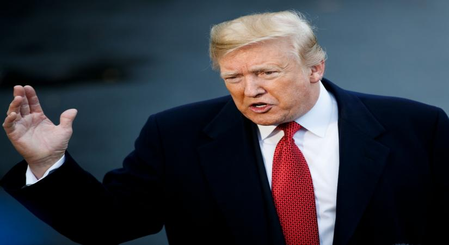
Sacramento: US President Donald Trump announced Tuesday a $175 billion missile defence system dubbed the “Golden Dome,” appointing US Space Force General Michael Guetlein to lead what Trump described as a “Manhattan Project-scale” initiative.
During the Oval Office announcement, flanked by US Defence Secretary Pete Hegseth and Guetlein, Trump revealed that the project would be completed within three years and would protect the entire continental United States, including Canada, from aerial threats, Xinhua news agency reported.
“It is a great day for America,” Trump declared, seated beside a poster showing the continental US painted gold with artistic depictions of missile interceptions. “This design for the Golden Dome will integrate with our existing defense capabilities and should be fully operational before the end of my term.”
The ambitious system is designed to create a comprehensive network of satellites capable of detecting, tracking, and intercepting incoming missiles. Trump touted the system would be “capable of intercepting missiles even if they are launched from other sides of the world and even if they are launched from space.”
The project represents a substantial evolution from what was initially announced as the “Iron Dome for America” in the administration’s first week, before being renamed “Golden Dome” by the Pentagon in February, possibly due to trademark concerns with Israel’s existing Iron Dome system.
Guetlein previously served as the vice chief of space operations with the US Space Force and has extensive experience in missile defense and space-based capabilities.
In March, Guetlein described the project’s scope, calling it “on the order of magnitude of the Manhattan Project” and saying it would “take concerted effort from the very top of our government” and “national will to bring all this together.”
The $175 billion price tag announced by Trump fell significantly below earlier Congressional Budget Office estimates, which suggested the system could cost between $161 and $542 billion over 20 years, according to a Bloomberg report on May 5.
A National Research Council study from 2012 estimated that the total cost of a space-based, boost-phase missile defense system could be as much as $831 billion (in 2025 dollars).
Separately, Senator Tim Sheehy, Republican of Montana, who is heading a “Golden Dome caucus,” recently told a crowd, “It will likely cost in the trillions if and when Golden Dome is completed,” according to Space News.
Defence analysts have also raised questions about the project’s technical feasibility, citing the difficulty of scaling up Israel’s Iron Dome to protect a landmass approximately 400 times larger. The Israeli system primarily defends against short-range rockets and artillery, while the American system would need to counter advanced ballistic and hypersonic missiles.
Leading contractors vying for key satellite-based components include SpaceX, Palantir, and Anduril, which propose launching a constellation of hundreds to thousands of low Earth orbit satellites to provide continuous three-dimensional tracking and intercept capability.
On Capitol Hill, congressional Republicans have moved to include 27 billion dollars for Golden Dome in a 150 billion dollar defense package attached to Trump’s tax-cut reconciliation bill.
According to Space Force officials quoted in various news reports, the technology would rely heavily on space-based sensors and interceptors to provide early detection and rapid response capabilities. Proponents argue that modern technology would make this concept more viable, unlike previous missile defence concepts such as the Strategic Defence Initiative of former US President Ronald Reagan.
Opponents caution that weaponising space risks a new arms race and undermines decades-old arms-control treaties.
Union of Concerned Scientists research director Laura Grego described the plan as “fantasy,” in a statement released This January, warning that adversaries could develop countermeasures to defeat a space-based shield.
The group said those previous proposals to get around weaknesses of Ground-Based Midcourse Defence system by building space-based missile defenses had repeatedly been abandoned “because they are expensive, very technically challenging, and readily defeated.”
“Trump’s idea of a space-based missile defence is a bad investment,” it concluded.
IANS


















